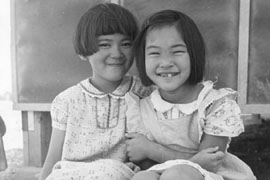By Cale Ottens
Cronkite News Service
WASHINGTON – The Department of the Interior has declared two Arizona sites national historic landmarks – one from the state’s prehistory and the other from a darker time in modern history.
Interior Secretary Ken Salazar on Wednesday gave the designation to a World War II-era Japanese-American internment camp near Parker and to one of the earliest human settlement sites in the Americas, near present-day Sierra Vista.
The Poston Elementary School Unit 1 site in La Paz County and the Murray Springs Clovis Site in Cochise County were among 26 national historic landmarks named Wednesday.

The Poston site was known as the Colorado River Relocation Center in World War II, when it was an internment camp for thousands of Japanese Americans who were forced from their homes on the West Coast and relocated by the federal government during the war.
It was the second of 10 such camps in the country and, for several years, the largest.
The relocation programs were carried out in the name of national security in the months after the Japanese attack on Pearl Harbor. Documents nominating the site for historic designation note that such camps are significant because they “reflected wartime hysteria, racist sentiment and the military’s professed inability to gauge the loyalty of Japanese Americans to the United States.”
“The lives of Japanese Americans at the center and the impact of the OIA (Office of Indian Affairs, which ran the Poston site) plans on the people and the site are represented by the remaining historic resources,” the nominating document said.
There were originally three Poston camps, but only one remains.
The La Paz County camp is the only relocation center that still has an above-ground complex of elementary school buildings from the war years, which were built with adobe bricks manufactured on site by the citizens who were held there. The land is on the Colorado River Indian reservation in western Arizona.
The Murray Springs Clovis Site sits on public land that is managed by the Bureau of Land Management, said Diane Drobka, a spokeswoman for the bureau’s Gila District. She said the land is special because it contains human artifacts dating back more than 13,000 years.
“It’s totally incredible what has been found there,” Drobka said. “The Clovis culture is the earliest occupation of the Americas, period – north and south.”
She said one reason the site was nominated for historic designation is “because it yielded so much information about this (prehistoric) culture, and it will continue to do so.” Findings have included bison kill, a mammoth kill and possibly even a horse kill, she said.
“It is one of the most significant Clovis sites ever found,” Drobka said. “How many sites do we find that are 13,000 years old?”
National Park Service spokesman Mike Litterst said the historic designations signed Wednesday by Salazar – 26 national historic landmarks and one national natural landmark designation – “is essentially an honorary designation.”
“It doesn’t change the ownership at all of the property. It doesn’t change the level of protection,” Litterst said. “The owner of the national historic landmark can still make alterations on the property – they can even tear it down if they want to.”
But with the designation, he said, landowners can apply for technical assistance and grant money from the National Park Service. The service’s grant funds are only awarded to sites with the national landmark designation and typically go toward historic preservation work, rehabilitation work and other maintenance projects, Litterst said.
Drobka said the bureau plans to manage the land the same way it has been since it acquired the property in 1986, which is primarily for its scientific resources.
“It’s also an important tourism attraction for the local community,” she said.






